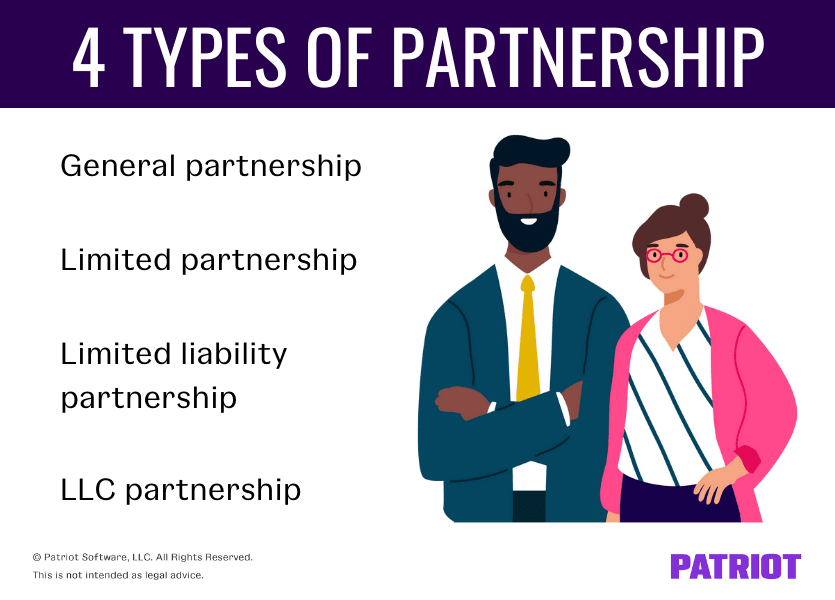When you start your venture, you have a number of decisions to make. What are you going to offer? What market are you going to target? Are you going to run your business solo or have a helping hand? If you don’t want to run your business alone, you might consider forming a partnership.
Read on to learn about the different types of partnership and how each can benefit your small business.
Overview of partnerships
One of the first things you decide as a business owner is your type of business structure. As a brief recap, here are the main business structures you can choose from:
- Sole proprietorship
- Partnership
- Corporation
- S corporation
- LLC
A partnership is a business that two or more individuals own and operate together. Unlike other business structures, there are multiple types of partnership you can establish.
The relationship between the partners, type of ownership, and duties of each partner are typically outlined in a partnership agreement. Depending on the amount of participation in the partnership, partners may be liable for business debts.
If you’re familiar with partnerships, you’ve likely heard of general and limited partnerships. However, there are a couple of other forms of partnership out there. Check out the four types of partnership below:
- Limited partnership
- General partnership
- Limited liability partnership
- LLC partnership
Types of partnership in business
Now that you have a little more background information on partnerships, dive into the four types of partnership in business below.
There are many pros and cons of partnerships. Be sure to weigh the advantages and disadvantages before you decide which type of partnership is the best route for your business.

General partnership
A general partnership is a company owned by two or more individuals who agree to run the business as partners or co-owners.
Unless otherwise agreed, each partner has an equal share of profits and losses. Partnership agreements play a major role in general partnerships that don’t evenly split duties and shares.
In general partnerships, partners manage the business and assume responsibility for the partnership’s debts.
If you plan on forming a general partnership, create a formal agreement stating each partner’s role and shares. Be sure to also specify how you plan on selling or closing the business if the partnership dissolves.
Because the business is not a separate entity from its partners, profits in general partnerships are only taxed at the personal income level. Profits are not taxed at the company level.
General partnerships are easy to establish, low-cost, and flexible. On the downside, your personal assets are at risk in a general partnership. Not to mention, partners are liable for each other’s actions.
Limited partnership
Limited partnerships are more structured than general partnerships and have both general and limited partners. To start a limited partnership, you need at least one general and one limited partner. So, what’s the difference between a general partner and a limited partner?
A limited partner is well … limited. Limited partners only serve as investors for the partnership. Typically, a limited partner does not have decision-making rights. They get ownership but don’t have as many risks and responsibilities as a general partner.
Limited partners can lose their status if they become too involved in managing the company (e.g., signing legal documents or contracts). If you’re a limited partner, be careful about the activities you do and the decisions you make in the partnership.
General partners own and operate the company and assume liabilities for the partnership. A general partner has control and responsibility when it comes to the limited partnership.
Limited partnerships are generally very attractive to investors due to the different responsibilities of the general and limited partners.
Limited liability partnership
A limited liability partnership, or LLP, is a type of partnership where owners aren’t held personally responsible for the business’s debts or other partners’ actions.
With an LLP, you typically can’t lose your personal assets if someone takes legal action against your business. But, partners can be held liable if they personally do something wrong.
The protection an LLP partner receives varies from state to state. Check your state’s rules before you form a limited liability partnership. In some states, only certain professions can form an LLP, such as lawyers, doctors, or accountants.
LLPs make it easy to add or remove partners. And unlike some other types of partnership, you can have liability protection from other members’ actions (depending on your state).
LLC partnership
An LLC partnership can have two or more owners, called members. Limited liability companies with multiple members are referred to as multi-member LLCs or LLC partnerships.
Under an LLC partnership, members’ personal assets are protected. In most cases, members can’t be sued for the business’s actions or debts. Members can be held liable for other members’ actions, though.
Most businesses can form an LLC partnership. LLC partnerships offer personal liability protection and tax flexibility for members.
Taxing business partnerships
Limited, LLC, and limited liability partnerships are all taxed like a general partnership. All four types of partnership are pass-through entities.
Pass-through taxation is when the tax “passes through” the business onto another entity, such as the business owner. Pass-through taxes are only taxed one time. The business does not pay taxes. Instead, the partners do.
During tax time, a partnership must file the following forms:
- Form 1065
- Schedule K-1
Form 1065, U.S. Return of Partnership Income, is a form that partnerships use to report their business’s annual financial information. The form includes information about the company’s profits and losses, taxes, payments, and deductions.
Use Schedule K-1 (Form 1065), U.S. Return of Partnership Income, to report your partnership’s income and expenses. Each partner must file their own Schedule K-1. Attach Schedule K-1 to Form 1065 to report each partner’s share of the business’s income and expenses.
LLC partnerships, limited partnerships, and general partnerships can choose to be taxed as corporations. To do so, they must submit Form 8832 to the IRS. LLC partnerships can also be taxed as an S corporation using IRS Form 2553.
Comparing partnerships: Chart
Phew, a lot of partnership information was just thrown at you. To clear up any confusion about the different types of partnership in business, check out our helpful chart below.
| General Partnership | Limited Partnership | Limited Liability Partnership | LLC Partnership | |
| Number of owners? | 2 or more | 2 or more | 2 or more | 2 or more |
| Type of owner? | Partner | At least one limited and one general partner | Partner | Member |
| Personal liability protection? | No | Yes (only limited partners) | Yes | Yes |
| Protection from other members’ actions? | No | Yes (only general partners) | Yes | No |
| Who can form one? | Anyone | Anyone | Only certain professions, depending on the state | Anyone |
Need an easy way to track your business’s income and expenses? Patriot’s accounting software lets you streamline the way you record transactions. Try it for free today!
Like what you read? Let’s connect, friend! Like us on Facebook and let’s get talking.
This is not intended as legal advice; for more information, please click here.



